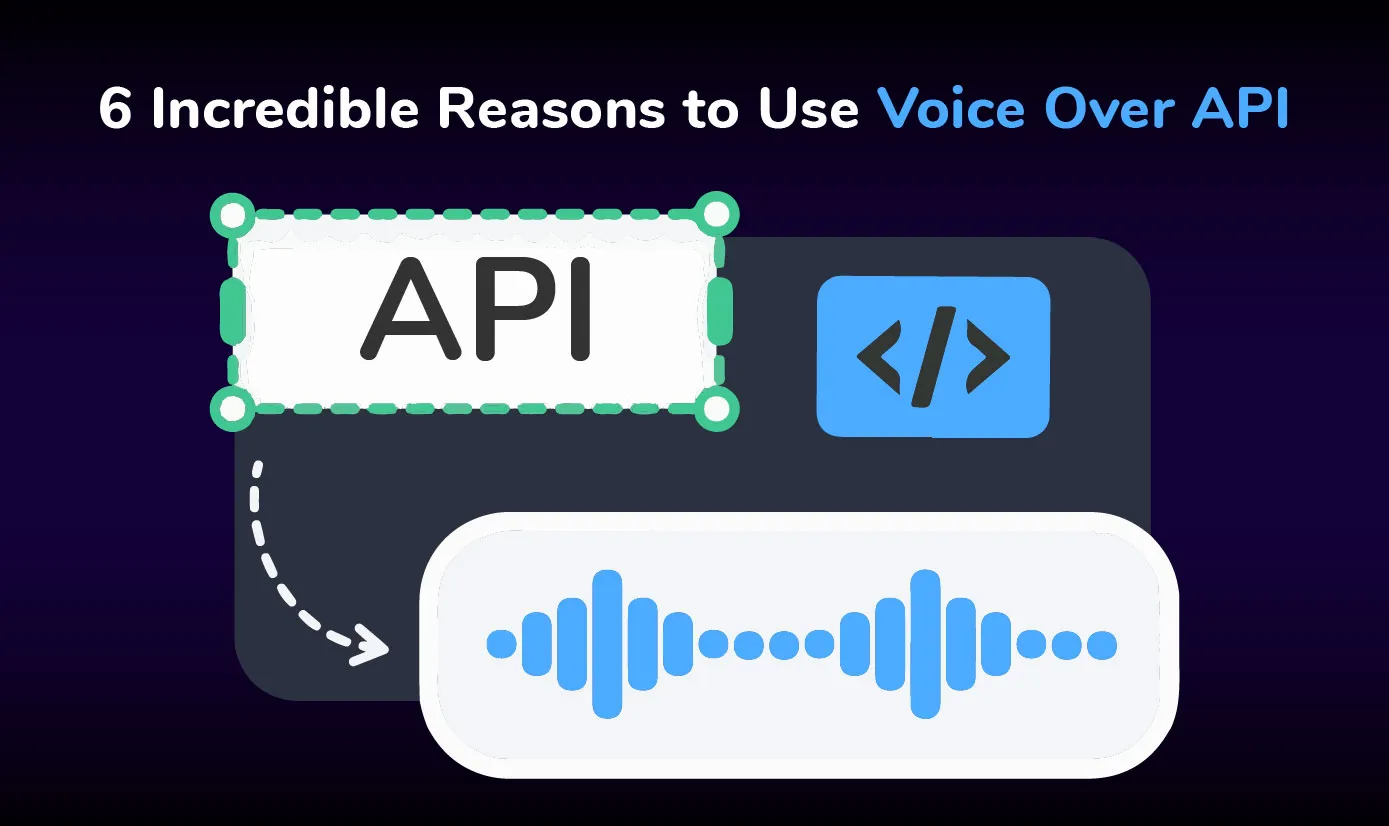Voiceovers use some of the most advanced AI voiceover technologies and sound authentic. In fact, the audio is so convincing that listeners cannot distinguish between a human performer and an AI text-to-voice generator. These platforms for text-to-speech provide APIs so that engineers and product developers may easily incorporate a voiceover API into their current technology stack. There are countless options. This produces natural voice overs for podcast episodes, articles, videos, and other media.
We expand on voiceover APIs in this blog post. This covers their nature, potential applications for brands and content producers, and the unique advantages they present.

What is Voice Over API?
A Voice Over API (Application Programming Interface) is a way for developers to access the functionality of a voiceover service programmatically. It allows you to create voice overs with the help of software or an application rather than recording them manually.
Voiceover APIs allow you to integrate voiceover functionality into your own application, website or software, enabling you to generate voice overs on the fly, programmatically control the voice and language, and adjust different parameters like the speed, volume, and intonation. The API uses a combination of Text to speech(TTS) and speech synthesis technologies to convert written Text into spoken words. This can help create voice prompts, audio guides, and instructional videos, among other applications. Additionally, considering the scalability and flexibility requirements for such applications, exploring Kubernetes architecture can optimize the deployment and management of these voiceover services.
How Can You Use a Text-To-Speech API?
There are several ways you can use a Text-to-Speech (TTS) API:
Creating voice overs for videos or presentations: A TTS API can convert the written script into spoken words. This can help develop voiceovers for videos or presentations without needing a human voiceover artist.
- Generating audio content for podcasts and audiobooks: A TTS API can convert written content into spoken words. This can be useful in creating audio content for podcasts or audiobooks.
- Building interactive voice assistants: A TTS API can convert written Text into spoken words. This can create interactive voice assistants responding to user input with speech.
- Creating navigation prompts for GPS and map applications: A TTS API can convert written navigation instructions into spoken words. This can help generate navigation products for GPS and map applications.
- Building accessibility tools: A TTS API can convert written Text into spoken words. This can help develop accessibility tools for visually impaired people with other accessibility needs.
- Enhancing chatbots and virtual assistants: TTS API can convert written Text into spoken words. This can help create more natural, interactive conversations for chatbots and virtual assistants.
These are a few examples of how a TTS API can be used, but the possibilities are endless. The API can be integrated into various applications or services, depending on your needs.

Why use an AI Voiceover API?
There are several reasons why you might choose to use an AI voiceover API:
- Natural Sounding Voices: AI voiceover APIs use advanced machine learning techniques to generate natural-sounding voices similar to human agents. This makes them perfect for a wide range of applications, from video and audio content to interactive voice assistants and chatbots.
- Flexibility: AI voiceover APIs provide more flexibility than traditional human voiceovers. They can generate a wide range of voices, accents and languages, as well as allow you to customize various parameters such as volume, rate, and intonation, which can help you achieve the perfect voiceover for your project.
- Speed and Efficiency: AI voiceover APIs can generate voiceovers much faster than traditional methods. This means you can get your voice overs done in the short time it would take to record them manually.
- Scalability: With an AI voiceover API, it’s easy to scale your voiceover needs up or down as required. You can produce as many voice overs as you need without worrying about the costs and logistics of hiring voiceover artists.
- Cost-Effective: AI voiceover APIs are often offered on a subscription basis; this eliminates the need for hiring a voiceover artist, which can be costly.
- Language support: AI voiceover APIs offer support for multiple languages; this allows you to create voice overs in any language you want, which can be helpful if you create content for a global audience.
In summary, AI voiceover APIs provide a convenient and efficient solution for creating high-quality voice overs that can be customized and adapted to fit a wide range of applications and use cases and offers an affordable alternative to human voiceover artists.
Conclusion
Voiceover API technology is becoming increasingly important in today’s digital landscape as it allows businesses and developers to easily integrate voice capabilities into their products and services. With the rise of voice assistants and the growing popularity of voice-controlled devices, the demand for voiceover API technology will only continue to grow. Companies can use a voiceover API to add voice recognition, natural language processing, and text-to-speech capabilities to their products, allowing for more efficient and user-friendly interactions. Additionally, voiceover API technology can be used for accessibility purposes, making it easier for individuals with disabilities to interact with technology. Overall, the benefits of voiceover API technology make it an ideal tool for businesses and developers looking to improve their products and stay ahead of the competition.
Frequently Asked Questions
What is a Voiceover API?
A Voiceover API, or speech synthesis API, is a software interface that allows developers to integrate text-to-speech functionality into their applications. This allows users to convert written text into spoken words, enabling applications such as voice assistants, navigation systems, and more.
How does a Voiceover API work?
A Voiceover API typically works by sending a request to the API with the text that needs to be spoken, along with parameters such as the language, voice, and speech rate. The API then converts the text into speech and returns the audio file in the desired format, such as MP3 or WAV.
Why use an API for AI voice?
There are a few alternatives available when creating a voice over. To manually render each text-to-speech voice over, you can upload a script, or you can utilize an API to automatically render voice overs when your system calls for them. The latter path has a few advantages.
Can a Voiceover API be used in multiple languages?
Yes, many Voiceover APIs support multiple languages like Wavel API, allowing developers to create applications that can reach a global audience.
Is it possible to customize the voice using a Voiceover API?
Yes, many Voiceover APIs allow developers to customize the voice by choosing from a variety of pre-built voices or even creating their own custom voice.

.webp)










